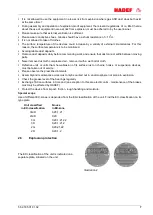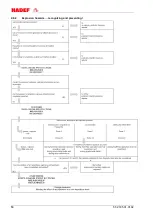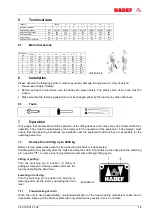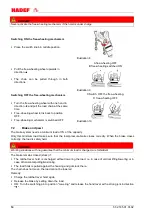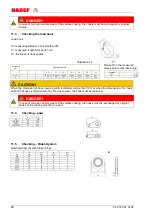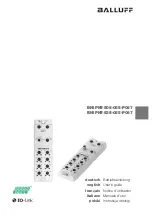
8
5.52.185.01.01.02
Example of ATEX classification:
II
2
G
IIB
c
T4
CE-marking
European Union
explosion-proof operating
material
II
device group / application
I
II
danger of mine damp
other areas prone to explosion
2
device category
1
2
3
Use in zone 0
Use in zone 1
Use in zone 2
G
EX atmosphere
G
D
....caused by gas, steam, fog
...caused by dust
IIB
explosion group
IIA
IIB
IIC
limit gap widths (MESG) > 0,9 mm
limit gap widths (MESG) 0,9 >= 0,5 mm
limit gap widths (MESG) < 0,5 mm
c
type of protection
c
k
construction safety
encapsulation of liquids
T4
Temperature class - gas-
es
(for dust only the temper-
ature in °C is stated)
T1
T2
T3
T4
T5
T6
limit temperature 450 °C
limit temperature 300 °C
limit temperature 200 °C
limit temperature 135 °C
limit temperature 100 °C
limit temperature 85 °C
2.6.1
EX-Category
EX- Zone
1+21
2+22
1+21
2+22
Device category
2
2
Expl.-group of gases
IIB
IIB
Temperature class - gases
Temperature class - dust
T4
135°C
T3
200°C
DANGER!
The classification for the device can be found on the EX-type plate on the unit.
The device must only be used in the classification stated or in a lower classification.
2.6.2
Surface temperature of the devices
DANGER!
The temperature class mentioned on the EX-type plate on the unit must be observed, - make sure
that the max. surface temperature is even fallen short of.
DANGER!
The maximum surface temperature of the equipment must always be lower than the ignition
temperature of the gas/vapour/dust/air mixture. Equipment which has been classified in higher
temperature classes is, of course, also approved for use in applications with lower temperature
classes. As gas/air mixtures for T5 do not occur with normal use, and only very rarely occur for T6,
for specific gas/air mixtures such as carbon disulphide (IIC), our hoists are not rated for these
temperature classes and must not be used for these classes.







